A History of the Transitory
The tradition of temporariness in Chinese architecture (1)
All things are a flux, with never any rest,
Whirling, rising, advancing, retreating.
Force water and it spurts, force an arrow and it goes far:
All things are propelled in circles, undulating and revolving-
(Jia Yi, The Owl [Funiano fu], 2nd century B.C.)
One of the most conspicuous characteristics of the visible spaces of the Chinese colony in Hungary - their markets, fast food restaurants, shops - is their temporariness. Quite evidently, these spaces were made to be transitory : they use the cheapest building materials (corrugated iron, chipboard, artificial stone, etc.), they are constructed with little care, and it is not much of an exaggeration to say that it would take no more than a few minutes to dismantle them and set them up elsewhere. Markets are, of course, the most obvious manifestations of this provisionality, but even when we take a look at a more stationary Chinese space, we will find that the new tenants have not interfered with the deep structure of the building. The Chinese shops use lightweight, mobile shelves, and the goods are kept in cardboard boxes inside the selling area. The ornaments of Chinese restaurants are cheap imitations: the columns are made of rolled-up sheet iron painted red, the pictures on the walls are taken from inexpensive calendars, and many of the decorations are made of plastic. It does not take an in-depth study to see that the owners or tenants of these buildings are not inclined to make lasting investments to have these spaces reflect their taste or needs. Obviously, the Chinese living with us have a different relationship to their spaces than Westerners, who are used to a life of settlement.
The contrast between the two attitudes is especially pronounced in Hungary , where the Chinese colony appeared during the years that followed the political transition, marked by ill-defined conditions. One of the hallmarks of traditional Western urban planning is the aspiration for durability, and it is over this environment, intended to be lasting, that the network of the Chinese immigrants' transitory spaces extends, its nodes filling the unguarded "crevices" of the existing system.
Naturally, there are a number of reasons for this makeshift way of life: vague immigration regulations, the lack of a desire to settle for life, and the scarcity of capital all play a part in this. Yet, whoever has visited China - and saw similar provisional spaces there - will think the roots of this attitude to the built environment must run deeper than that. A look at the Chinese tradition of architecture reveals that the transitoriness, temporariness, transience of the living space is one the most enduring characteristics of Chinese civilisation. In the following, I would like to offer a few notes on this historical tradition.
***
The cradle of Chinese civilisation, the plains around the lower and middle reaches of the Yellow River , is one of the most fertile regions in the world, but it is also one with the least permanent features. With its frequent but incalculable floods and constantly changing bed, the river fertilises the land again and again, but also destroys houses and rewrites the hydrography of the region. Producing food chiefly by agriculture, people cannot live far from the river, its tributaries and their plains, while the land does not favour permanent settlements. Moreover, the region has extremely limited stone resources, and as the size of the cultivated area has grown, wood needed to be obtained from ever greater distances. As a consequence, the chief building materials were clay, adobe, packed earth and loess; stone was used only for the foundations, while wood was for pillars and beams, but only in the more representative structures. Thus, settlements in the early phase of Chinese civilisation consisted of buildings that were cheap and easy to build, but which were not very durable and had a short lifespan. Later this civilisation conquered a vast area, and its people transformed even those regions to their likeness where different construction methods would have been possible. The model and the attitude had become so ingrained, that adaptation to the new environments always remained only partial.
***
From its very beginnings until recently, Chinese civilisation was based on agriculture, and even its elite thinkers looked upon farming as the basis of life. The significance of agriculture defined the worldview and thinking of the Chinese. (2) Their fundamental experience was being at the mercy of nature, the impossibility of influencing the changes, or rather cycles, of nature - the succession of the four seasons, the origin and cessation of life. Human life and human institutions were accordingly considered a part of nature, itself an unending process of destruction and rebirth. Individual things and lives are fragile and contingent; what remains eternal is the pattern things follow, the mould they are cast in. The individual tree, person, building, city or dynasty comes to life, develops and then dies - the pattern it follows, however, is always the same. As a result, the Chinese see history, too, as a cyclical phenomenon: chronological time has no beginning; history is the succession of dynasties, each following a similar trajectory of development; and the scale used for the dating of events is not absolute, but starts anew with the beginning of the current emperor's reign. A given phenomenon of the present is not a unique and original point in the vast flow of events, but one of the manifestations of a recurring pattern - neither the first, nor the last.
And just as life begins and ends, so buildings and settlements are destroyed and reborn as part of the great cycle of nature. (3) Floods, fires and wars would devastate the Chinese cities, but the survivors always rebuilt them, either in the same location or nearby. Throughout the centuries, the ancient capitals, Beijing , Xi'an and Luoyang , changed their location within their respective regions, often also their names, as the builders searched for the most advantageous spot to rebuild after their destruction. If Rome was constructed to be the Eternal City , the creators of Chinese towns did not seek immortality for their buildings.
Thanks to this attitude, not only did the transience of life become one of the favourite subjects of Chinese poetry, but in time "city mourning" poems became a genre in their own right. Like humans, cities die after a short period of bloom, and by mourning for them, the poet also laments his own mortality, as did Wei Zhuang in the 9th-10th centuries:
Chang'an lies in mournful stillness: what does it now contain?
Ruined markets and desolate streets, in which ears of wheat are sprouting.
Fuel gatherers have hacked down every flowering plant in the Apricot Gardens ,
Builders of barricades have destroyed the willows along the Imperial Canal .
All the gaily-coloured chariots with their ornamented wheels are scattered and gone,
Of the stately mansions with their vermilion gates less than half remain. (4)
Characteristically, after the ruin commemorated by Wei Zhuang, the remaining wood of Chang'an was tied up into rafts, and floated down the river to Luoyang , the new capital - which was erected on a site that had been the home of several capitals during the preceding 1500 years. The practice of recycling old building materials has survived into the most recent of times: in the late 1970s, the same unit of the army is said to have been charged with rebuilding a famous section of the Great Wall that had taken away the stones at the beginning of the decade, to construct its barracks. (5)
***
It follows from the worldview of the Chinese that their relationship to originality - in both senses of the word - is different from what we are accustomed to. Since every phenomenon is the recurrence of an old model, there is no inherent value in something being new or being made from the original material. It is exactly the age of the old models that has proved them to be correct and worthy of imitation - there is consequently no need to change them. Furthermore, should a new idea appear, it should be presented as if it were an ancient idea in a new form. Hence, development is always slow and organic: no political, economic or cultural revolutions took place during the two millennia of the Chinese Empire. Though there were styles and trends that were dominant in the art of a given age, we cannot speak of real stylistic periods in the history of Chinese art. Traditional Chinese architecture also remained conservative. The forms elaborated in antiquity were used until the beginning of the 20th century, and the new solutions offered by technological development led only to minor alterations within the given framework, never touching upon the basic structure of the buildings.
And since individual objects, lives and institutions are contingent and transient, things do not need to be original in their physical reality. The copy, if it faithfully follows the ancient model, is often considered as valuable as the original. Typically, the painter held to be one of the greatest in all Chinese history is Wang Weit of the 8th century, none of whose works have survived - all we know are purported copies of his paintings, and several of these are known to be copies of copies. Artistic training itself consisted of the copying of old masters, and the fledgling artist could work on his own personal style - if ever - only when he had mastered the ancient models. (6) Architecture represented a similar attitude: what made a building original was not the use of old materials, but that it followed the original form. The design of most buildings, in any case, allowed the easy replacement of its elements: when a column, beam or roof tile got worn or damaged, a new one was introduced. Thus, every particle of a building could have been replaced over time - without any change in their form. And what is most important: the Chinese would look upon this building, new in its materials, but ancient in its form, as an "original".
***
The attitude of the Chinese towards their built environment may well have been influenced by their relationship to property, which is unlike the European concept, based on the principles of Roman law. Land, the chief means of production, could not be privately owned: though hereditary estates may have appeared, the principle was that all land was at the disposal of the emperor. (7) The land belongs to one as long as he uses it, and then the state will allocate it to someone else.
Compared with arable land, houses and other kinds of real estate were of secondary importance, but if in their case private property is recognised to some extent, it does not have the legal buttresses we in the West are used to. We might even say a residential house in China is less real estate than a personal effect, and since all but the most imposing residences are made of cheap and readily available materials, they are not even the most valuable effects. Typically, when a hero joins the outlaws in Water Margin (Shuihu Zhuan), a 14th-century novel, the first thing he does is to destroy his own house, in a gesture of leaving society. The Chinese are far less attached to their houses, whose lifespan is often shorter than their owners', than Westerners. The locale they consider their point of origin is their homeland: the Chinese living outside China still gather according to their birthplaces, and when they feel the end is near, they try to return there - or at least have their ashes sent back. (8)
The Communist policy of nationalisation was an outgrowth of the traditional relationship to property. All real estate became communal property, and people received their homes from the factory, the commune, the office or the party - the ties with one's flat grew even weaker. Only the past few decades have seen changes in this respect: many flats became privately owned from the 1980s on, but it was only with a 2004 amendment of the constitution that private property became inviolable, and the state now has to pay for areas it expropriates. (9) At the same time, land is still owned by the state or the community, so while the house may be owned by an individual, the lot it stands on belongs to the state.
***
In conclusion, it is worth mentioning the technology of traditional Chinese architecture, which may also influence the attitude towards the built environment. (10) There were essentially two modes of construction, employing wooden frames or solid walls. Elegant buildings (palaces, temples, the homes of dignitaries) had wooden frames. On a foundation of stone, bricks or packed earth, which rises above ground level, stand the wooden posts, bearing a very complex beamed roof. Roof tiles or thatch were used to cover the wooden structure, while the spaces between the posts were filled with adobe walls, lattices, doors and windows, or were left empty, as in the case of pavilions. The walls bear no weight.
For solid walls, packed loess, clay, dried or, occasionally, baked bricks were used. Packed walls, the most frequent solution, are made by laying loess or clay in thin layers inside the formwork, and then packing it. The roof tries to imitate the structure of wooden-frame houses, as only the latter have real prestige: the builders of solid-wall buildings introduce posts that are structurally unnecessary, arched roofs and upturned eaves.
Both types of buildings are then made of materials that are susceptible to all sorts of damage, as from fire, water and pests. On the other hand, the buildings are easy to construct and renovate, the parts, which in the case of wooden-frame structures need not be made on site, can be replaced individually.
The drive for originality is conspicuously absent from Chinese architecture. The character of a dwelling house is determined by its natural environment; the public buildings - whether they be temples, offices, palaces or schools - are practically interchangeable: they have identical floor plans, structures and construction methods in all parts of the empire. It seems, then, that there is no desire in the Chinese to live in original, customised environments - the taste of the individual appears in his or her portable ornaments.
***
As I hope to have shown, Chinese tradition relates differently to built spaces than the Western. The buildings are executed with incredible technical virtuosity, and are admired the world over - but their function is not to separate man's world from the natural environment. In traditional Chinese thinking, man is a part of nature, and the same is true of his buildings: they too participate in the natural cycle, as everything else in the world. A structure, or even a city, is not to break this cycle; the builder does not want to take a space out of the eternal flow of time, unlike the makers of a Gothic cathedral, constructed over generations. Continuity is attained by keeping and following ancient models.
The exceptional endurance of Chinese civilisation is due precisely to the power of these ancient, and invisible, models and structures. This continuity does not rely on the material environment; it owes its survival to the spiritual tradition, human bonds and social fabric of the millennia. Recent decades have seen the appearance of two processes in this respect: thanks to external forces, this system of traditions is losing its sway, and much of what has been said above is becoming invalid; on the other hand, the network of the carriers of this system is becoming global. One of the most interesting questions of the near future is what the results will be of the encounter and intensive cohabitation of one of the most ancient civilisations and the rest of the world.
1. I wish to acknowledge my gratitude for the help provided by Dr. Barnabás Csongor, Dr. Mária Ferenczy and Dr. András Várnai for this essay, and for the thought-provoking discussions we had.
2.See, e.g., Fung Yu-lan: A Short History of Chinese Philosophy. Collier-Macmillan 1948/1997.
3.Japan offers an example of the passive observation of this cycle transformed into active performance. The Shintoist shrine of the city of Ise - one of the holiest places in the country - is ritually destroyed every twenty years, and is rebuilt in the same exact form on an adjacent lot. The gods are then transferred to the new temples, which are dismantled at the end of their twenty-year service. The tradition has been followed for 1300 years, during which the form of the buildings did not change. The next ritual rebuilding will take place in 2013. Cf. K. Tange-N. Kawazoe: Ise: Prototype of Japanese Architecture . Cambridge, Mass.: MIT Press, 1965.
4. " The Lament of the Lady of Qin." Trans. by Lionel Giles.
http://academic.hws.edu/chinese/huang/mdln312/supplementary/WeiZhuang.htm
5.Péter Polonyi: Kína . [Panoráma Országkalauz: China] Second edition. Panoráma, 2002.
6.Pál Miklós: A sárkány szeme [The Eye of the Dragon]. Budapest, Corvina, 1973, 55-58.
7.This principle appears in the Book of Odes, one of the oldest classics, thus: "Under the wide heaven, / All is the king's land" (Shijing 205). The quote later appeared in several books of law as a vindication.
8. A typical manifestation of this tradition is the Tung Wah Coffin Home in Hong Kong , in which the coffins of those Chinese who died abroad are stored, who wanted to be buried in their homeland, but their wish has come up against temporary obstacles. The website of the institution is at: http://www.tungwahcsd.org/chi/ts/tscentre.php?steid=227&id=101 .
9. Article 13 of the fourth amended Constitution of the People's Republic of China . Cf. , e.g. , http://english.people.com.cn/constitution/constitution.html .
10.For more on the subject, see, e.g., T. Thilo: Hagyományos kínai építészet [Traditional Chinese Architecture]. Budapest, Corvina, 1977.
|
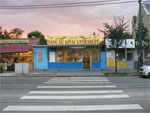
Fast food restaurant called "Capital of the Tang Dinasty", Budapest, XV. district - tin and plastic rule

The lower valley of the Yellow river

Houses with tiled rooftops and wooden structures in the Forbidden City of Beijing
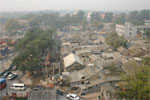
Old Beijing district awaiting demolition
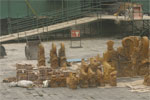
Old rooftop decoration being replaced for new pieces in the Forbidden City, Beijing

Abandoned house, near Beijing
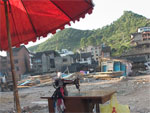
Tailor's shop on an empty lot, city of Taijiang
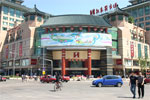
New shopping center in Beijing - the lot belongs to the state, the building belongs to the investor
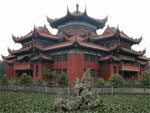
Temple in Sichuan province - the look of a fortress hides traditional wooden structures
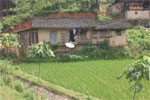
Vernacular house with solid walls in Southern China
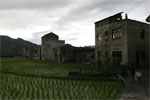
Multi-storey vernacular houses in Southern China
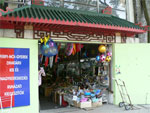
Shop entrance, originally storage hall, Budapest, VII. district
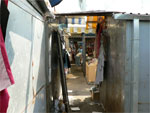
Four Tigers market, Budapest |